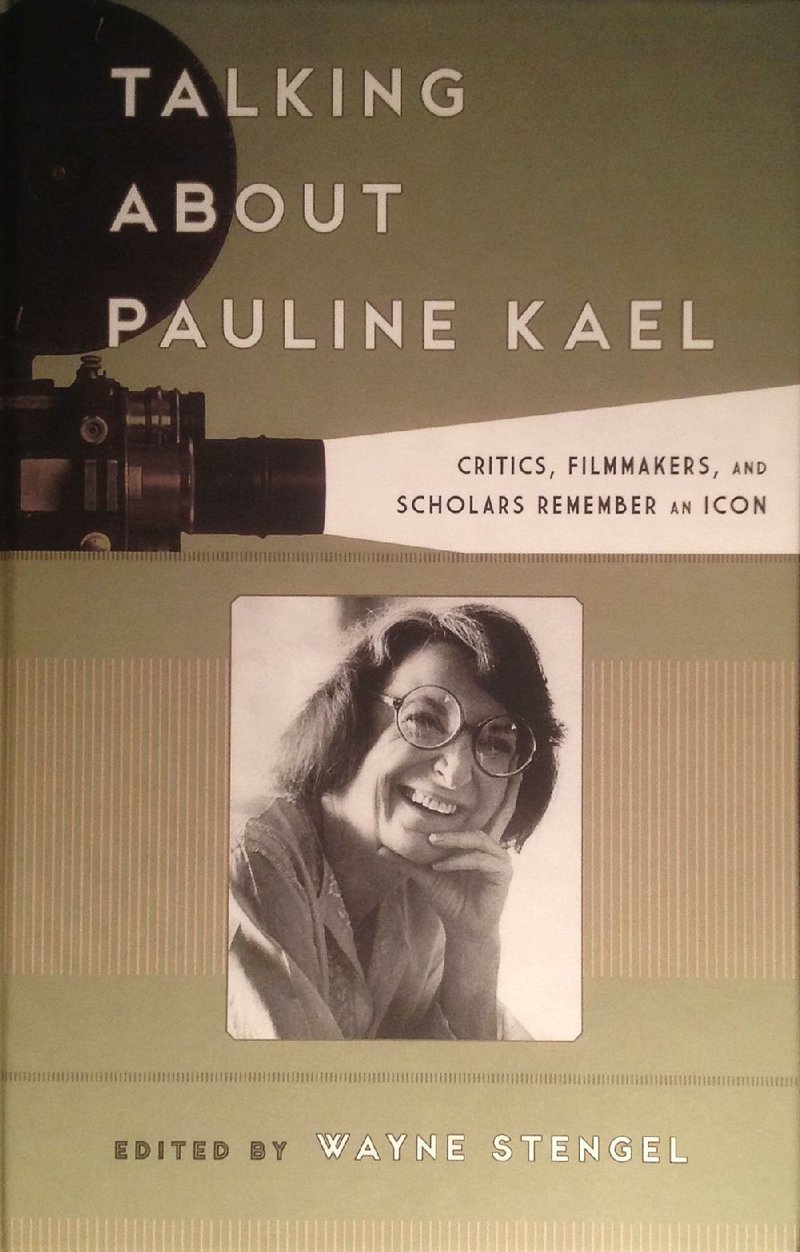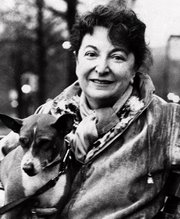The following is an excerpt from my essay that appears in Talking About Pauline Kael (Rowland & Littlefield, $80), a new book edited by University of Central Arkansas professor Wayne Stengel. The book includes essays by Roy Blount Jr., filmmakers Joan Tewkesbury and Paul Schrader, critics Noel Murray, David Denby and Martin Knelman, as well as from many of Kael's colleagues and friends.
No one starts out wanting to be a sportswriter.
We long to be in the arena, and not just because that's where everyone's attention is focused and where the contests are decided. It is a cleaner and simpler way to live. We long, like Alexander Portnoy, "to be a center fielder, a center fielder and nothing more."
It's only when we begin, as (the fascist) Dirty Harry Callahan instructs us, to understand our limitations that we begin to negotiate compromise and insinuate ourselves into the periphery. We can't be the quarterback, but we may, for a while, be able to chase or block for him. We can't stand out in front of the band, perhaps, but maybe we can play the drums and if not that, load equipment on the bus. Finding ourselves less special than we assumed, we end up going to school, obtaining credentials, acquiring skills that may allow us to be of use to the world.
We discover ourselves as our possibilities foreclose. As we are thwarted, we are shaped.
I wanted to be a shortstop and I saw no reason why I couldn't be that, except that some other boys were stronger and faster than I. But the books of John R. Tunis promised me I could grow and improve, and if I did enough of that -- if I ran the extra lap, focused keener or wanted more -- I could overtake my betters.
And so I carried bricks in either hand as I ran up and down stadium stairs, and I read Ted Williams on The Art of Hitting. I told myself the lie we all secretly believe: that I was not like the others, that there was within me a kernel that would inevitably erupt into greatness.
When I first started reading Pauline Kael, I was still convinced of my own specialness. I thought very little about the movies.
Before I started reading Kael, movies were just movies, something to do on a Saturday night. (Or, more often, a Tuesday night when we could go for a dollar.) I liked them, because who doesn't like movies? But I gave no more thought to how they came into existence, to who made them or why, than I considered the manufacturing processes of vanilla ice cream or Coca-Cola.
The precise reasons why I looked up her review of Bernardo Bertolucci's Last Tango in Paris in The New Yorker in the Airline High School library are obscure to me 40 years later, though I imagine they had to do with the movie's "scandalous" nature. I expect that I had heard something about Brando and butter, and the overtness of Maria Schneider that convinced me I wanted to know more. In any case, I'm sure I was hoping for photographs.
But I was unprepared for the exotic thing my eyes flushed from the page -- a wild-colored plume of flapping verbiage smacked me in the face:
"The movie breakthrough has finally come. Exploitation films have been supplying mechanized sex -- sex as physical stimulant but without any passion or emotional violence. The sex in Last Tango in Paris expresses the characters' drives. Marlon Brando, as Paul, is working out his aggression on Jeanne (Maria Schneider), and the physical menace of sexuality that is emotionally charged is such a departure from everything we've come to expect at the movies that there was something almost like fear in the atmosphere of the party in the lobby that followed the screening. Carried along by the sustained excitement of the movie, the audience had given Bertolucci an ovation, but afterward, as individuals, they were quiet. This must be the most powerfully erotic movie ever made, and it may turn out to be the most liberating movie ever made. ... Bertolucci and Brando have altered the face of an art form. Who was prepared for that?"
Certainly not this 14-year-old infielder.
I don't mean to suggest I was a feral kid. I grew up around books and a touching suburban veneration of books that verged on fetishism. Our house had bookcases tight with yards of Reader's Digest condensed hardbacks, book club editions of popular novels, a rich trove of paperbacks and a few volumes that reflected some fairly esoteric interests in Greek mythology and poetry. (My father was a fan of Philip Larkin and Alfred Lord Tennyson. He also had a copy of E.E. Cummings Collected Poems 1922-1938, though I got the feeling he didn't much care for any of them aside from "i sing of Olaf glad and big," which he could recite from memory.)
We had two sets of encyclopedias -- Grolier's Encyclopedia Americana and their New Book of Knowledge (which I imagined I had outgrown by the time I went looking for intelligence on Last Tango) and a 10-volume set of Grolier's Classics bound in red leatherette. (And which I was studiously working my way through. I read abridged versions of Lamb's Essays for Elia and La Rochefoucauld's Maxims and Reflections before I ever read Pauline Kael.)
While my parents did not subscribe to The New Yorker, they took many magazines in their Bossier City home -- among them National Geographic, Time and Newsweek, Redbook and, for a time, McCall's (briefly Kael's employer, though I never noticed).
But Kael was different from the other writers I had noticed -- there was a sense of urgent performance driving her words. She wasn't just talking about the show in the manner of certain genial sportswriters I liked reading; there was a sense that, at least in some sense, her work was the show. Or at least a show. Kael wasn't simply describing what was happening in the movie -- reading the review, I didn't even get much of a sense of what happening in the movie -- she was using the occasion of the movie to talk about things unrelated to whether Last Tango in Paris was an amusing diversion. She seemed to be communicating something important about the way we could live in the world. And though I didn't completely understand what she was saying, I was intoxicated by the rhythm and rack of her words, mesmerized by the sparks they made as they knocked one against the other:
"His first sex act has a boldness that had the audience gasping, and the gasp was caused -- in part -- by our awareness that this was Marlon Brando doing it, not an unknown actor. In the flat, he wears the white T-shirt of Stanley Kowalski, and he still has the big shoulders and thick-muscled arms. Photographed looking down, he is still tender and poetic; photographed looking up, he is ravaged, like the man in the Francis Bacon painting under the film's opening titles. We are watching Brando throughout this movie, with all the feedback that that implies, and his willingness to run the full course with a study of the aggression in masculine sexuality and how the physical strength of men lends credence to the insanity that grows out of it gives the film a larger, tragic dignity."
This was not what I had expected; it was different from the way my friends and I talked about or thought about movies, and at the time I doubt I understood much of what Kael was going on about. I thought of Francis Bacon as some dead Englishman in a ruffled collar (thank you, Encyclopedia Americana). I had a vague notion of Stanley Kowalski as the character who hollered "Stella!" in A Streetcar Named Desire but I'm not sure I associated the role with Marlon Brando -- who I knew only as Don Corleone.
"The colors in this movie are late-afternoon orange-beige-browns and pink -- the pink of flesh drained of blood, corpse pink. They are so delicately modulated ... that romance and rot are one."
I was in no position to have an opinion about Kael's opinion; her verdict was inconsequential to me. What mattered to me in that moment, and what matters to me today, was that voice -- erudite yet chatty, and charged with an urgent, rapturous enthusiasm that made me want to understand whatever foreign language she was speaking.
It would be years before I'd have a chance to see Last Tango.
When I did, I couldn't help but be a little disappointed. Bertolucci's film didn't strike me the same way it had Kael a decade before, in part because we hadn't seen the same film. It wasn't fresh for me as it was for her; I'd seen various paler and more lurid iterations of the film in the meantime, I had seen the Mad magazine parody (and possibly a Saturday Night Live skit? Maybe I dreamed it. The Internet won't give it up). I had been wised up about Brando and seen One-Eyed Jacks and On the Waterfront and become the sort of person who took movies more or less seriously. But I knew that didn't matter because I'd been attending to Pauline Kael since that moment in early 1973.
I knew it was OK to disagree with that insistent, clangorous voice. I knew that was one of the things consenting adults did -- disagree about works of art. I was 23 years old and writing a column that ran on the front page of a newspaper three days a week before I realized that a writing life was possible for me. It is only in retrospect that I realized that the crazy lady writing about movies in the back of The New Yorker was one of the chief influences on my so-called career.
Kael was a firestarter, a flashy writer. I was a box of tinder.
She wasn't the only flashy writer I have ever loved; she probably wasn't even the first. But she is one who has stayed with me, even as I've outgrown other enthusiasms. I think fond thoughts for Bukowski and Scott Fitzgerald and Kurt Vonnegut, but when I read them these days I am slightly embarrassed by the avidity with which I consumed them in my youth. I love them still, but I understand that at least part of why I love them has to do with a nostalgia for my own callowness. I imitated them, I stole what I could, and now I feel a little sheepish in their presence.
Other novelists retain their difficulty -- I still wrestle with Roth and Bellow and Updike (and Donald Harington and others more obscure and too numerous to mention), though sometimes I am too aware of what the wise money says. And I think of Kael in the same way I think of these enduring novelists of the mid-20th century, coming to grips with a world that changed faster than it ever could have before, between my 12th and 15th birthdays, when I still thought it possible that I could be a shortstop.
Email:
pmartin@arkansasonline.com
blooddirtangels.com
Style on 11/01/2015

